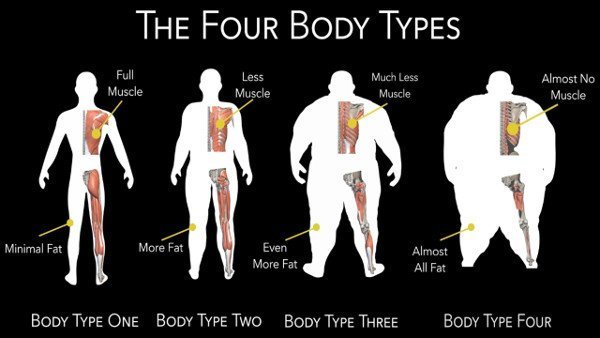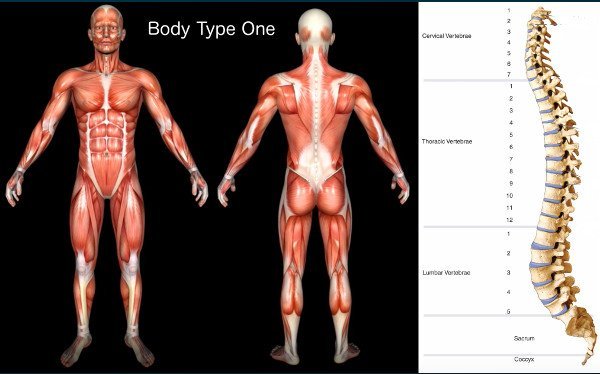
What is my body type? Are all human bodies born the same? For instance, do all human body types have the exact same amount of muscle and muscle mass, and do all experience obesity the same way?
No, all human bodies are not born the same and do not have the same amount of muscles/muscle mass nor do they experience obesity the same way.
Why is this so and how do we know for certain this is an indisputable fact?
Well, to start, it is a fact that the somatotype three body types — ectomorph, endomorph, and mesomorph — are irrelevant because they are not based on science. They are 100% unscientific, arbitrary, subjective shapes with no scientific backing of any kind. The same is true for the hormone body types, triangle body types, 10 body types, Kibbe body types, and any other body types.
The only body types that are based on real, actual science are The Four Body Types pioneered by Fellow One Research since 2003. We have the only Body Type Science in existence. So, then, how do you know what is my body type?
What is My Body Type – Muscle/Muscle Mass, Obesity
At birth, some human bodies have more muscles and muscle mass — some babies are more muscular, with a higher propensity towards athletics and symmetry, no less, and a lower proclivity towards obesity. Whereas at birth, other human bodies have more fat and fewer muscles and muscle mass — some babies are more prone to obesity with a higher propensity towards being less athletic and asymmetrical, no less. Genetics/DNA significantly influences things along with diet, exercise, and lifestyle choices. As the specific body grows through childhood into adulthood, genetics guide the way.

If you do a Google Search for “Human Body Anatomy” you will get multiple images and links for the currently agreed-upon mainstream scientific information for muscles (650-840 muscles), bones (270-206 bones), vertebrae (33-24 vertebra, most adults only have 24 since some of the lower ones fuse together over time), etc. and how those variables directly influence the structure and overall creation of the human body. When all these variables/data points are fully developed, built, and balanced the specific human body is a Body Type One – AKA, the Standard Scientific Human Body Anatomy Book Body Type One BT1:

However, as already mentioned, not all human bodies are born fully developed and balanced, and thus all human bodies are not a Body Type One.
Genetics is the key culprit in understanding what is my body type — why there is such a range of different body types. As your human body develops from birth through childhood into adulthood, your choices in terms of diet, exercise, and lifestyle do matter. But genetics/DNA have already greatly predetermined your body type from day one in terms of the development of vertebrae (posture) and muscles/muscle mass in relation to skinny fat and obesity, no less.
So, how do we define body type relative to “fully developed and balanced” versus “fully undeveloped and unbalanced”?
Vertebrae, Muscle, Muscle Mass, and Obesity – What Is My Body Type?

26 Vertebrae (7 cervical, 12 thoracic, 5 lumbar, 1 sacrum, 1 coccyx) – as the main “loom” of the human body, the spine and vertebrae define how muscles/muscle mass is “weaved” throughout the body. When everything is genetically woven exactly as intended, you get the Body Type One (BT1). Just like the image on the left/above.
What if, on one specific human body, the muscle(s) directly relative to thoracic vertebra number three – T3 – are all underdeveloped? How would that affect posture? How would it affect metabolism? How would it affect obesity proclivity?
We know science recognizes that 1 pound of muscle mass burns 6 calories per day, but 1 pound of fat and skinny fat (cellulite, loose/saggy skin, thin fat, crepey skin, normal weight obesity) only burns 2-3 calories daily. Thus, metabolism is directly, negatively affected by underdeveloped and undeveloped muscle/mass. We also know that each individual vertebra houses specific muscles, whether fully developed, fully undeveloped, or somewhere in between, which directly, negavitely influences posture, at least.

What if, on another specific human body the cervical 1-4 muscles are all underdeveloped? On yet another specific human body, the thoracic 5-10 vertebrae have underdeveloped muscle and mass. Further still, on another human body, nearly all the vertebrae have undeveloped muscles/mass, from at least thoracic 1 through thoracic 12, lumbar 1-5, sacrum vertebra, and the coccyx vertebra, just like the Body Type Four image to the right/below? How is the posture, no less, for all those different specific human bodies affected? How seriously would metabolism be affected in a negative way? And how does obesity correlate?
And on and on. With so many potential different body types and body shapes in relation to no less than developed or undeveloped muscles/muscle mass and each vertebra, what does all this mean? How does each individual vertebra affect the overall functioning of the human body? These are all questions Fellow One Research’s Body Type Science seeks to answer.
Dividing Up the 33 Vertebrae Into Four Different Body Types

Body Type One (BT1) – All 33 Vertebrae Fully Developed, relative to the 24 Moveable & Two Fixed Bones (0 Vertebrae Underdeveloped)
Body Type Two (BT2) – Between 32 and 22 Vertebrae Fully Developed, relative to the 24 Moveable & Two Fixed Bones (1-8 Vertebrae Underdeveloped)
Body Type Three (BT3) – Between 21 and 11 Vertebrae Fully Developed, relative to the 24 Moveable & Two Fixed Bones (9-17 Vertebrae Underdeveloped)
Body Type Four (BT4) – Between 10 to 0 Vertebrae Fully Developed, relative to the 24 Moveable & Two Fixed Bones (18-26 Vertebrae Underdeveloped)
What Is My Body Type – How Does Muscle/Muscle Mass and Fat (Obesity) Differ?

Muscles and muscle mass, especially fully developed and properly balanced, are the armor of the human body. Muscle generates heat and speed while providing strength, endurance, agility, and the like. Muscle is vital to the structure of the human body, healthy metabolism, and overall health. Moreover, muscle uses energy most efficiently and effectively, holds the energy best, and allows for withstanding pressure infinitely better than fat or skinny fat.
Fat uses energy much less efficiently and effectively, although it is a solid insulator. Fat cannot hold the energy or withstand pressure nearly as well as fully and properly developed muscle and muscle mass. Skinny fat is really no different. Becoming more obese (adding additional excess fat) may help hold the energy and withstand pressure more in the short term, but at an unacceptable cost to the health of the body.
How can all of this be more accurately quantified and qualified to truly understand what is my body type? Through our Body Type Science Research Data. The Four Body Types research focuses on vertebrae and muscles/muscle mass development and/or underdevelopment relative to diet, exercise, lifestyle, metabolism, BMR, Body Mass Index (BMI), skinny fat, obesity, and genetics/DNA, no less, to scientifically understand the human body and define body type.






